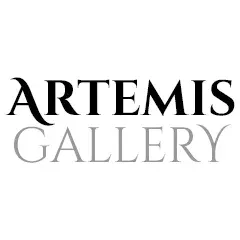











Egyptian Polychrome Gesso Coffin Lid – 1946 Provenance
Starting: $65,000
Egypt, Late Dynastic Period, 26th to 31st Dynasty, ca. 664 to 332 BCE. An incredible exterior coffin lid carved from hardwood and depicting a serene countenance atop an elaborately decorated body. Painted gesso atop the lid is decorated to show the red-orange face with almond-shaped eyes and elongated canthi, a protruding nose above pouty lips, and a black chinstrap with a net-patterned false beard. Each wig lappet has vertical stripes of alternating hues with serrated tips, and a wadjet peers out on each shoulder. The huge wesekh collar is replete with checkerboards, blue and red triangles, rosettes, and drop-form patterns. The leg panels show the deceased laying atop a lion-headed table beneath the head of Anubis, flanked by the mourning goddesses Isis and Nephthys, with a sun disc, a winged scarab, and two wadjet eyes in the panel above, and two representations of the god Khnum to its sides. The lower legs display several standing funerary deities flanking three columns of hieroglyphs that perhaps identify the deceased. Size: 74″ L x 18″ W (188 cm x 45.7 cm)
Anthropoid coffins like this example first appeared by the Middle Kingdom – skillfully carved so as to outline the mummy’s body and decorated with the visage and wig of the deceased individual. Such coffins not only served to copy the mummy’s form kept within, but also served as actual substitutes for the bodies if that the mummy’s body was lost or destroyed. As time progressed, these coffins were decorated with more extensive iconographic programs, presenting a greater number of inscriptions.
This sarcophagus and others like it were traditionally carved from cedar, though cedar was only used by those wealthy families who could afford the exotic hardwood. Interestingly, cedar wood was not native to Egypt. Egypt did not have verdant forests filled with tall trees, and unfortunately most of its native lumber was of relatively poor quality. Thus, they relied on importing to acquire hardwoods – ebony imported from Africa, cedar and pine from Lebanon. One fabulous obelisk inscription by Thutmose III attests to the luxury of treasured hardwoods. It reads as follows, “They brought to me the choicest products . . . consisting of cedar, juniper and of meru wood . . . all the good sweet woods of God’s Land.” The rarity of cedar meant that coffins like this one were reserved for those who could afford them.
The iconography of Anubis’ disembodied, jackal-form head is symbolically significant due to his direct association with the dead, the process of embalming, and the trial known as the ‘weighing of the heart.’ Anubis, based on the real animal called the African golden jackal, is usually depicted as either a canine or a man with a canine head. Like many Egyptian deities, the role of Anubis changed over time. During the First Dynasty (ca. 3150 to 2890 BCE), he was a protector of graves, a member of the embalming entourage, and the de facto ruler of the underworld. In the Middle Kingdom period (ca. 2050 to 1550 BCE), Osiris claimed Anubis’ role as lord of the underworld. Anubis was still a preeminent presence during the ‘weighing of the heart’ ceremony where the weight of the heart of the deceased would be measured against that of a feather of Ma’at (or feather of truth) to observe if the deceased had been virtuous and forthright during their stay in the realm of the living. Should the heart weigh less than the feather, the deceased would be permitted to enjoy to resplendency of the Fields of Osiris in the afterlife. Should the heart weigh even a gram more than the feather, both the heart and soul of the deceased were cast into the maw of Ammit, a horrifying chimeric beast indentured with punishing evil souls for the rest of eternity.
For a similar example of a coffin lid from the Thirtieth Dynasty with a lower portion beneath, please see Ikram, Salima and Aidan Dodson. “The Mummy in Ancient Egypt: Equipping the Dead for Eternity.” Thames and Hudson, London, 1998, p. 241, fig. 324.
For another example of a coffin lid with dense decorations from the 26th Dynasty, please see The Metropolitan Museum of Art, accession number 30.3.44a,b.
For an example of a coffin lid showing the deceased praying to each of the funerary deities, please see The British Museum, museum number EA6693.
Provenance: private Hawaii, USA collection; ex-private Ezeldeen Taha Eldarir collection, New York, USA, purchased in December, 1946 and imported from Egypt in November, 1948; ex-Salahaddin Sirmali collection, Egypt; appraised by Mr. Hossen Rashed, head of the Egyptian antiquities house

